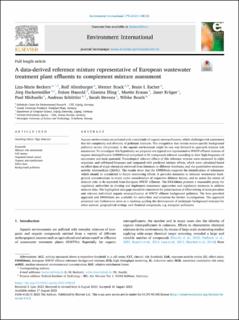| dc.contributor.author | Beckers, Liza-Marie | |
| dc.contributor.author | Altenburger, Rolf | |
| dc.contributor.author | Brack, Werner | |
| dc.contributor.author | Escher, Beate I. | |
| dc.contributor.author | Hackermüller, Jörg | |
| dc.contributor.author | Hassold, Enken | |
| dc.contributor.author | Illing, Gianina | |
| dc.contributor.author | Krauss, Martin | |
| dc.contributor.author | Krüger, Janet | |
| dc.contributor.author | Michaelis, Paul | |
| dc.contributor.author | Schüttler, Andreas | |
| dc.contributor.author | Stevens, Sarah Lena Inge Marie | |
| dc.contributor.author | Busch, Wibke | |
| dc.date.accessioned | 2024-02-20T11:22:53Z | |
| dc.date.available | 2024-02-20T11:22:53Z | |
| dc.date.created | 2023-10-03T08:52:07Z | |
| dc.date.issued | 2023 | |
| dc.identifier.citation | Environment International. 2023, 179 . | en_US |
| dc.identifier.issn | 0160-4120 | |
| dc.identifier.uri | https://hdl.handle.net/11250/3118633 | |
| dc.description.abstract | Aquatic environments are polluted with a multitude of organic micropollutants, which challenges risk assessment due the complexity and diversity of pollutant mixtures. The recognition that certain source-specific background pollution occurs ubiquitously in the aquatic environment might be one way forward to approach mixture risk assessment. To investigate this hypothesis, we prepared one typical and representative WWTP effluent mixture of organic micropollutants (EWERBmix) comprised of 81 compounds selected according to their high frequency of occurrence and toxic potential. Toxicological relevant effects of this reference mixture were measured in eight organism- and cell-based bioassays and compared with predicted mixture effects, which were calculated based on effect data of single chemicals retrieved from literature or different databases, and via quantitative structure-activity relationships (QSARs). The results show that the EWERBmix supports the identification of substances which should be considered in future monitoring efforts. It provides measures to estimate wastewater background concentrations in rivers under consideration of respective dilution factors, and to assess the extent of mixture risks to be expected from European WWTP effluents. The EWERBmix presents a reasonable proxy for regulatory authorities to develop and implement assessment approaches and regulatory measures to address mixture risks. The highlighted data gaps should be considered for prioritization of effect testing of most prevalent and relevant individual organic micropollutants of WWTP effluent background pollution. The here provided approach and EWERBmix are available for authorities and scientists for further investigations. The approach presented can furthermore serve as a roadmap guiding the development of archetypic background mixtures for other sources, geographical settings and chemical compounds, e.g. inorganic pollutants. | en_US |
| dc.language.iso | eng | en_US |
| dc.publisher | Elsevier | en_US |
| dc.rights | Attribution-NonCommercial-NoDerivatives 4.0 Internasjonal | * |
| dc.rights.uri | http://creativecommons.org/licenses/by-nc-nd/4.0/deed.no | * |
| dc.title | A data-derived reference mixture representative of European wastewater treatment plant effluents to complement mixture assessment | en_US |
| dc.title.alternative | A data-derived reference mixture representative of European wastewater treatment plant effluents to complement mixture assessment | en_US |
| dc.type | Journal article | en_US |
| dc.type | Peer reviewed | en_US |
| dc.description.version | publishedVersion | en_US |
| dc.source.pagenumber | 14 | en_US |
| dc.source.volume | 179 | en_US |
| dc.source.journal | Environment International | en_US |
| dc.identifier.doi | 10.1016/j.envint.2023.108155 | |
| dc.identifier.cristin | 2181166 | |
| cristin.ispublished | true | |
| cristin.fulltext | original | |
| cristin.qualitycode | 1 | |

